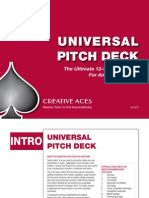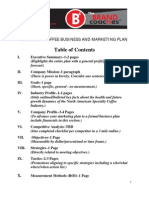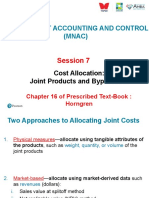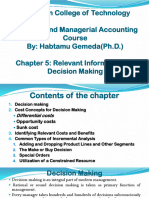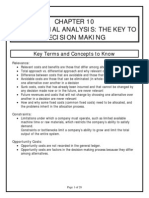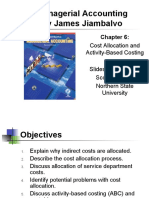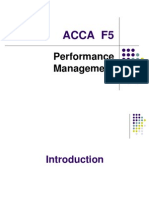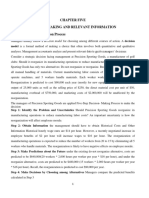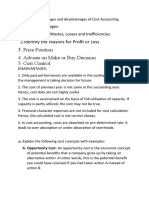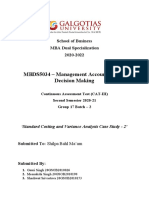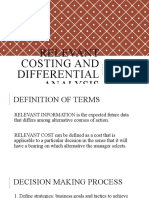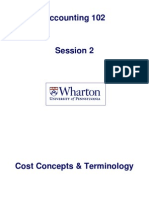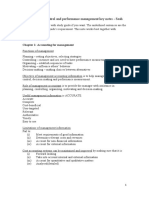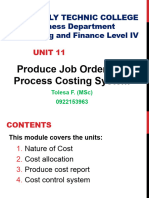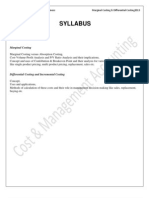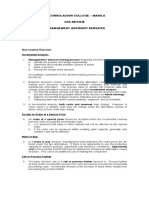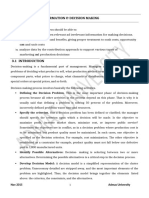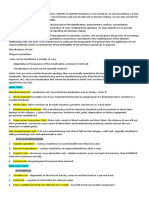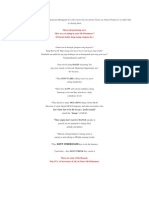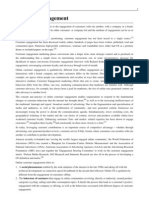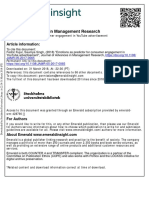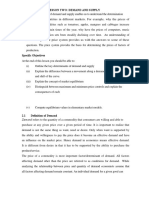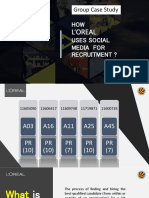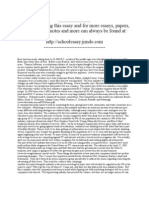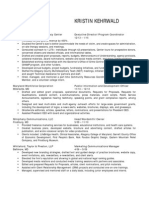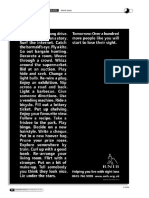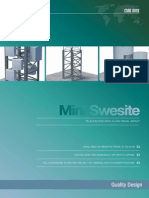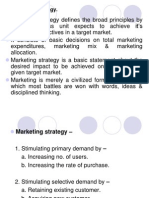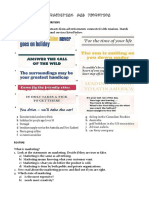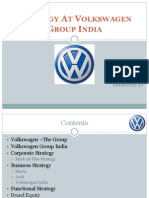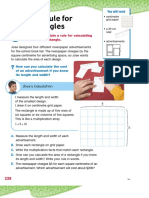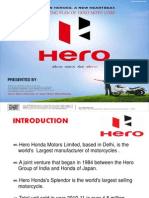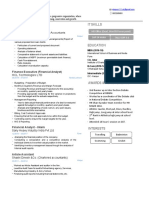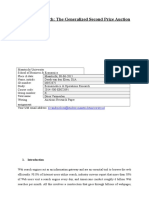Managerial Accounting
Managerial Accounting
Uploaded by
Paula Cxerna GacisCopyright:
Available Formats
Managerial Accounting
Managerial Accounting
Uploaded by
Paula Cxerna GacisOriginal Description:
Copyright
Available Formats
Share this document
Did you find this document useful?
Is this content inappropriate?
Copyright:
Available Formats
Managerial Accounting
Managerial Accounting
Uploaded by
Paula Cxerna GacisCopyright:
Available Formats
Management Accounting
SW YOO
Chapter 14 DECISION MAKING: RELEVANT COSTS AND BENEFITS
1. Decision Making Process (1) Six Steps in the Decision Making Process (a) Clarify the decision problem (b) Specify the criterion (c) Identify the alternatives (d) Develop a decision model: The model includes the criterion, the constraints, and the alternatives. (f) Collect the data (g) Select an alternative Note) Although the managerial accountant collects and presents quantitative information (e.g., cost or profit), a skilled manager should rely on his or her judgment and experience to evaluate the qualitative factors of each situation, factors which often do not easily fit into decision models. (2) Determining Usefulness of Information (a) Relevance: Information is relevant if it is pertinent to a decision problem. (b) Accuracy: Information must be precise. (c) Timeliness: Information must be available in time for a decision. (3) Managerial Accountant's Primary Role in the Decision Making Process To provide information relevant to the decisions faced by managers; That is, (a) Decide what information is relevant to each decision problem, and (b) Provide accurate and timely data, keeping in mind the proper balance between these often conflicting criteria. 2. Identifying Relevant Revenues/Costs A relevant revenue/cost is a revenue/cost that is applicable to a particular decision that should have a bearing on which alternative a manager selects. Avoidable costs are relevant costs that can be eliminated (in which or in part) as a result of choosing one alternative over another. All revenues/costs are avoidable, EXCEPT: (1) Sunk costs: A cost that has already been incurred and that cannot be avoided regardless of which course of action a manager may decide to take. (2) Future revenues/costs that do not differ between the alternative at hand. 3. Analysis of Decisions (1) Accept or Reject a Special Offer (a) With excess (idle) capacity: Only variable costs associated with the special offer are relevant. Fixed costs are usually irrelevant. (b) No excess capacity: The opportunity cost of the lost contribution margin from regular higher priced sales and variable costs associated with the special offer are relevant. (2) Make or Buy a Product or Service The key is the proper handling of fixed costs. Since the per-unit cost of a product includes a unitized portion of fixed costs (i.e., fixed costs that may continue even if the product is purchased elsewhere at a lower price), the information should be presented to emphasize that total costs will not change with the number of units produced. (3) Add or Drop a Service, Product, or Department The key is the proper handling of fixed costs & opportunity cost. (a) Ascertain whether fixed costs are avoidable or unavoidable because although a product line cannot cover ALL its fixed costs, it may be covering its AVOIDABLE fixed costs and at least contributing toward the unavoidable fixed costs; (b) The opportunity cost of lost CM, including the effects on the other operation, should be also factored into the decision. (4) Joint Products: Sell or Process Further The key is considering only the increase in process costs after split-off point (called separable processing
14-1
Management Accounting
SW YOO
cost) and comparing it to the increase in revenue the extra processing brings. The split-off point is the point in the process at which the products are distinguishable from one another. All manufacturing costs up to that point are joint costs (which are usually allocated to the each product based on relative sales value method). Those joint costs are sunk costs and irrelevant to sell now or process further decision. (5) Decisions Involving Limited Resources The key is that a decision should be made on the basis of the CM per unit of scare resource, not on the basis of the CM per product, when there are limitations on machine time, labor hours, or raw materials (scarce resources). A decision model which considers multiple scarce resources is linear programming (See appendix). (6) Techniques for Addressing the Impact of Uncertainty (a) Sensitivity analysis: A technique for determining what would happen in a decision analysis if a key prediction or assumption proves to be wrong. (b) Decisions based on expected values: The expected value of a random variable (e.g., CM) is equal to the sum of the possible values for the variable, each weighted by its probability. 4. Activity-Based Costing and Decision Making (1) The relevant-costing concepts in an activity-based-costing environment do not change. What will change is the decision makers ability to determine costs and benefits that are relevant to the decision. (2) Costs that are fixed under a conventional costing system, for example, may not be fixed when multiple (and more appropriate) cost drivers are used. 5. (1) (2) (3) (3) The Common Pitfalls in Decision Making Sunk costs are irrelevant. Fixed costs may be misleading if presented on a per-unit basis. Allocated common fixed costs may be unavoidable and irrelevant; The avoidable costs should be identify. Opportunity costs are relevant, and therefore, should be identified and included in a decision analysis.
14-2
Management Accounting
SW YOO
EXAMPLES 1. Sunk Costs are not Relevant Costs A manager at White Co. wants to replace an old machine with a new, more efficient machine. New machine: List price Annual variable expenses Expected life in years $90,000 80,000 5 Old machine: Original cost Remaining book value Disposal value now Annual variable expenses Remaining life in years $72,000 60,000 15,000 100,000 5
A manager at White Co. wants to replace an old machine with a new, more efficient machine. Whites sales are $200,000 per year. Fixed expenses, other than depreciation, are $70,000 per year. Should the manager purchase the new machine? (Analysis 1) The manger recommends that the company not purchase the new because: Remaining book value Disposal value Loss from disposal $60,000 (15,000) $45,000
(Analysis 2: Comparative income analysis) For Five Years Sales Variable expenses Other fixed expenses Depreciation - new Depreciation - old Disposal of old machine Total net income Keep Old Machine $1,000,000 Purchase New Machine $1,000,000 Difference $ -
(Short Analysis: Relevant cost analysis) Relevant Cost Analysis Savings in variable expenses provided by the new machine Cost of the new machine Disposal value of old machine Net effect
14-3
Management Accounting
SW YOO
2. Special Orders Jet, Inc. receives a one-time order that is not considered part of its normal ongoing business. Jet makes a single product with a unit variable cost of $8. Normal selling price is $20 per unit. A foreign distributor offers to purchase 3,000 units for $10 per unit. Annual capacity is 10,000 units, and annual fixed costs total $48,000, but Jet, Inc. is currently producing and selling only 5,000 units. Should Jet accept the offer? Increase in revenue Increase in variable costs Increase in fixed costs Increase in net income or
3. The Make or Buy Decision (Outsourcing) Essex manufactures part 457A that is currently used in one of its products. The unit cost to make this part is: Direct materials Direct labor Variable overhead Depreciation of special equip. Supervisor's salary General factory overhead Total cost per unit $ 9 5 1 3 2 10 $ 30
The special equipment used to manufacture part 457A has no resale value. General factory overhead is allocated on the basis of direct labor hours. The $30 total unit cost is based on 20,000 parts produced each year. An outside supplier has offered to provide the 20,000 parts at a cost of $25 per part. Should we accept the suppliers offer? Cost Per Unit Outside purchase price Direct materials Direct labor Variable overhead Depreciation of equip. Supervisor's salary General factory overhead Total cost $ 9 5 1 3 2 10 $ 30 Cost of 20,000 Units Make Buy
14-4
Management Accounting
SW YOO
4. Adding/Dropping Segments Due to the declining popularity of digital watches, Lovell Companys digital watch line has not reported a profit for several years. An income statement for last year is: Segment Income Statement Digital Watches Sales Less: variable expenses Variable mfg. costs Variable shipping costs Commissions Contribution margin Less: fixed expenses General factory overhead Salary of line manager Depreciation of equipment Advertising direct Rent - factory space General admin. expenses Net loss $ 500,000 $ 120,000 5,000 75,000
200,000 $ 300,000
60,000 90,000 50,000 100,000 70,000 30,000
400,000 $ (100,000)
Assuming all of the general expenses and depreciation are unavoidable, should Lovell retain or drop the digital watch segment? (Analysis 1: Comparative income analysis) Comparative Income Solution Keep Digital Watches Sales Less variable expenses: Mfg. expenses Freight out Commissions Total variable expenses Contribution margin Less fixed expenses: General factory overhead Salary of line manager Depreciation Advertising direct Rent - factory space General admin. expenses Total fixed expenses Net loss $ 500,000 120,000 5,000 75,000 200,000 300,000 60,000 90,000 50,000 100,000 70,000 30,000 400,000 $ (100,000)
Drop Digital Watches $ -
Difference
14-5
Management Accounting
SW YOO
(Short Analysis: Relevant cost analysis) Contribution Margin Solution Contribution margin lost if digital watches are dropped Less fixed costs that can be avoided Salary of the line manager Advertising direct Rent - factory space Net disadvantage
5. Joint Product: Sell or Process Further Sawmill, Inc. cuts logs from which unfinished lumber and sawdust are the immediate joint products. Unfinished lumber is sold as is or processed further into finished lumber. Sawdust can also be sold as is to gardening wholesalers or processed further into presto-logs. Data about Sawmills joint products includes: Per Log Lumber Sawdust $ 140 $ 40 270 50 176 24 50 20
Sales value at the split-off point Sales value after further processing Allocated joint product costs Cost of further processing
Should we process the lumber further and sell the sawdust as is? Analysis of Sell or Process Further Per Log Lumber Sales value after further processing Sales value at the split-off point Incremental revenue Cost of further processing Profit (loss) from further processing Sawdust
14-6
Management Accounting
SW YOO
6. Utilization of Scarce Resources Ensign Company produces two products and selected data is shown below: Products 1 Selling price per unit Less: variable expenses per unit Contribution margin per unit Current demand per week (units) Contribution margin ratio Processing time required on machine A1 per unit $ 60 36 $ 24 2,000 40% 1.00 min. $ 2 50 35 $ 15 2,200 30% 0.50 min.
Machine A1 is the scarce resource because there is excess capacity on other machines. Machine A1 is being used at 100% of its capacity. Machine A1 capacity is 2,400 minutes per week. Should Ensign focus its efforts on Product 1 or 2? (Step 1) Products 1 Contribution margin per unit Time required to produce one unit Contribution margin per minute min. /min. 2 min. /min.
(Step 2) Allotting Our Scarce Resource (Machine A1) Weekly demand for Product 2 Time required per unit Total time required to make Product 2 Total time available Time used to make Product 2 Time available for Product 1 Time required per unit Production of Product 1 (Step 3) Product 1 Production and sales (units) Contribution margin per unit Total contribution margin Product 2 units min. min. min. min. min. min. units
14-7
Management Accounting
SW YOO
7. From the last example (example 6), recall the contribution margin for Product 1 was $24 and $15 for Product 2. Due to uncertainty, assume Martin has the following probable contribution margins for the two products. Product 1
Possible value of CM Probability
Product 2
Possible value of CM Probability
23.00 24.00 25.00
30% 50% 20%
14.00 15.00 16.00
10% 40% 50%
Compute the expected values. Product 1
Possible value of CM Probability Expected Value Possible value of CM
Product 2
Probability Expected Value
23.00 24.00 25.00
30% 50% 20%
14.00 15.00 16.00
10% 40% 50%
14-8
You might also like
- Reviewer For PartnershipDocument31 pagesReviewer For PartnershipJohn Michael Babas100% (7)
- Decision MakingDocument15 pagesDecision MakingSiddhant SangalNo ratings yet
- Responsibility Accounting Decision MakingDocument32 pagesResponsibility Accounting Decision MakingChokie NavarroNo ratings yet
- Universal Pitch DeckDocument16 pagesUniversal Pitch DeckAwesome Pitch Company80% (5)
- Specialty Coffee Business and Marketing PlanDocument24 pagesSpecialty Coffee Business and Marketing PlanPratik Udani0% (1)
- M6 Short Run Decision Making Relevant CostingDocument6 pagesM6 Short Run Decision Making Relevant Costingwingsenigma 00No ratings yet
- Weygandt Managerial 6e SM Release To Printer Ch07 NDocument58 pagesWeygandt Managerial 6e SM Release To Printer Ch07 NNgàyMaiTrờiLạiSángNo ratings yet
- CH 4Document17 pagesCH 4banteamlak asressNo ratings yet
- Session 7 & Ic - PGDM 2021 - 23Document28 pagesSession 7 & Ic - PGDM 2021 - 23Krishnapriya NairNo ratings yet
- Review For Final ExamDocument48 pagesReview For Final ExamMo KolapoNo ratings yet
- Relevant Costing NotesDocument27 pagesRelevant Costing NotesAnru PienaarNo ratings yet
- MCQ 14Document2 pagesMCQ 14Avishek BarmanNo ratings yet
- Cost Ii Chapter 5Document13 pagesCost Ii Chapter 5Biniyam TsegayeNo ratings yet
- Unit Five: Relevant Information and Decision MakingDocument39 pagesUnit Five: Relevant Information and Decision MakingEbsa AbdiNo ratings yet
- Cost AccountingDocument40 pagesCost AccountingJaypee FazoliNo ratings yet
- Chapter 5Document37 pagesChapter 5Korubel Asegdew YimenuNo ratings yet
- Cost and Management AccountDocument7 pagesCost and Management AccountMsKhan0078No ratings yet
- Marginal Costing: Definition: (CIMA London)Document4 pagesMarginal Costing: Definition: (CIMA London)Pankaj2cNo ratings yet
- P1 Solution CMA June 2019Document7 pagesP1 Solution CMA June 2019Awal ShekNo ratings yet
- ACC102-Chapter10new 000Document28 pagesACC102-Chapter10new 000Mikee FactoresNo ratings yet
- CHAPTER FOUR Cost and MGMT ACCTDocument12 pagesCHAPTER FOUR Cost and MGMT ACCTFeleke Terefe100% (1)
- Q3Finance Notes BookDocument13 pagesQ3Finance Notes Booksebastian.vduurenNo ratings yet
- MG WE FNSACC517 Provide Management Accounting InformationDocument9 pagesMG WE FNSACC517 Provide Management Accounting InformationGurpreet KaurNo ratings yet
- CH 20 SMDocument31 pagesCH 20 SMNafisah MambuayNo ratings yet
- Managerial Accounting by James JiambalvoDocument52 pagesManagerial Accounting by James JiambalvoAhmed AliNo ratings yet
- Acca F5Document133 pagesAcca F5Andin Lee67% (3)
- SCM-Ch11 - RELEVANT COSTINGDocument69 pagesSCM-Ch11 - RELEVANT COSTINGviktorfisicoNo ratings yet
- Pricing and Short Term Decision Making (Edited)Document58 pagesPricing and Short Term Decision Making (Edited)Vaibhav SuchdevaNo ratings yet
- P2 - Performance ManagementDocument11 pagesP2 - Performance ManagementWashington ShamuyariraNo ratings yet
- Chapter Five Decision Making and Relevant Information Information and The Decision ProcessDocument10 pagesChapter Five Decision Making and Relevant Information Information and The Decision ProcesskirosNo ratings yet
- CAT T7 Key NotesDocument31 pagesCAT T7 Key NotesMariam NawazNo ratings yet
- Part1 SEC BDocument135 pagesPart1 SEC BKhel MatiasNo ratings yet
- Write Advantages and Disadvantages of Cost AccountingDocument6 pagesWrite Advantages and Disadvantages of Cost AccountingAditya ManglamNo ratings yet
- Unit 7 Cost Accumulation TechniquesDocument21 pagesUnit 7 Cost Accumulation Techniquesestihdaf استهدافNo ratings yet
- Group 17 - MADM CAT III - Case Study 2 SolutionDocument7 pagesGroup 17 - MADM CAT III - Case Study 2 SolutionGauri SinghNo ratings yet
- Difference Between Absorption Costing and Marginal CostingDocument4 pagesDifference Between Absorption Costing and Marginal CostingIndu GuptaNo ratings yet
- Management Accounting Unit - 3Document26 pagesManagement Accounting Unit - 3himanshutiwari040305No ratings yet
- P2 - Performance ManagementDocument11 pagesP2 - Performance Managementmrshami7754No ratings yet
- Relevant Costing and Differential AnalysisDocument32 pagesRelevant Costing and Differential AnalysisEj BalbzNo ratings yet
- Chap002 Cost TermsDocument41 pagesChap002 Cost TermsNgái Ngủ100% (1)
- Session 02 CostsDocument28 pagesSession 02 CostsReya ZeeNo ratings yet
- F5 Class Test 1 New EPDDocument9 pagesF5 Class Test 1 New EPDEmon D' CostaNo ratings yet
- CAT T7 Key NotesDocument30 pagesCAT T7 Key NotesSeah Chooi KhengNo ratings yet
- MO-11-Producing Job OrderDocument181 pagesMO-11-Producing Job OrderDanoNo ratings yet
- Additional FINAL ReviewDocument41 pagesAdditional FINAL ReviewMandeep SinghNo ratings yet
- Week 5 Lecture Handout - Sols TemplateDocument3 pagesWeek 5 Lecture Handout - Sols TemplateRavinesh PrasadNo ratings yet
- Cost&Management Accounting Unit-2 PDFDocument19 pagesCost&Management Accounting Unit-2 PDFVishal RanjanNo ratings yet
- New CMA Part 1 Section BDocument135 pagesNew CMA Part 1 Section Bhmtairek85100% (1)
- Ma Revision Notes All Chapters Week 1 9Document87 pagesMa Revision Notes All Chapters Week 1 9fabianngxinlongNo ratings yet
- Chap. II - Relevant Information 2Document28 pagesChap. II - Relevant Information 2ybegdu100% (1)
- Summary and Reflection: Chapter 6: Cost-Volume-ProfitDocument5 pagesSummary and Reflection: Chapter 6: Cost-Volume-ProfitJohn Kenneth BoholNo ratings yet
- Lecture Aid - Relevant Costing Sumr 15Document2 pagesLecture Aid - Relevant Costing Sumr 15Jaira MoradaNo ratings yet
- MODULE 1.exercises - Answers OnlyDocument6 pagesMODULE 1.exercises - Answers OnlykonyatanNo ratings yet
- Unit 3 Acct312-UnlockedDocument21 pagesUnit 3 Acct312-UnlockedTilahun GirmaNo ratings yet
- CA IPCC Cost Accounting Theory Notes On All Chapters by 4EG3XQ31Document50 pagesCA IPCC Cost Accounting Theory Notes On All Chapters by 4EG3XQ31Bala RanganathNo ratings yet
- Cost Accounitng NotesDocument17 pagesCost Accounitng NotesDarlene JoyceNo ratings yet
- Cost AccountingDocument9 pagesCost AccountingPuneet TandonNo ratings yet
- Cost & Managerial Accounting II EssentialsFrom EverandCost & Managerial Accounting II EssentialsRating: 4 out of 5 stars4/5 (1)
- Manufacturing Wastes Stream: Toyota Production System Lean Principles and ValuesFrom EverandManufacturing Wastes Stream: Toyota Production System Lean Principles and ValuesRating: 4.5 out of 5 stars4.5/5 (3)
- Investments Profitability, Time Value & Risk Analysis: Guidelines for Individuals and CorporationsFrom EverandInvestments Profitability, Time Value & Risk Analysis: Guidelines for Individuals and CorporationsNo ratings yet
- Chapt-11 Income Tax - IndividualsDocument10 pagesChapt-11 Income Tax - Individualshumnarvios100% (4)
- Gross Income: Income Taxation 5Th Edition (By: Valencia & Roxas) Suggested AnswersDocument7 pagesGross Income: Income Taxation 5Th Edition (By: Valencia & Roxas) Suggested AnswersAnonymous qpUaTkNo ratings yet
- Comple CDocument1 pageComple CPaula Cxerna GacisNo ratings yet
- Elem Toc PDFDocument5 pagesElem Toc PDFKevin Alexis Hinostroza Cardenas67% (3)
- Kellogg's Indian ExperienceDocument11 pagesKellogg's Indian ExperiencervwassupNo ratings yet
- Meron Akong Tanong Sayo: "How Are You Doing in Your MLM Business?" (It Doesnt Matter Kung Saang Company Ka.)Document5 pagesMeron Akong Tanong Sayo: "How Are You Doing in Your MLM Business?" (It Doesnt Matter Kung Saang Company Ka.)Sy PerezNo ratings yet
- Raymond Premium ApparelDocument43 pagesRaymond Premium ApparelPoonam ChavanNo ratings yet
- Assignment - Contract LawDocument6 pagesAssignment - Contract Lawadrian marinacheNo ratings yet
- Customer Engagement ModelDocument9 pagesCustomer Engagement ModelSantosh Ravindra NadagoudaNo ratings yet
- MBA Notes On Brand Management, Moving The Brand DownDocument6 pagesMBA Notes On Brand Management, Moving The Brand DownCatherine MalenyaNo ratings yet
- Marketing - Market Research: A Case S Tudy Analysis of Kellogg's Indian ExperienceDocument5 pagesMarketing - Market Research: A Case S Tudy Analysis of Kellogg's Indian Experiencekiit2012-civil-212 civilNo ratings yet
- PredictorDocument15 pagesPredictorFiona Antoinette BesaNo ratings yet
- Ford ProjectDocument62 pagesFord ProjectKhalid Saiyad0% (1)
- Demand and SupplyDocument42 pagesDemand and SupplykirwanicholasNo ratings yet
- Group Case Study: HOW Uses Social Media For Recruitment ?Document14 pagesGroup Case Study: HOW Uses Social Media For Recruitment ?Rohit Kumar 4170No ratings yet
- Rin Detergent Case AnalysisDocument9 pagesRin Detergent Case AnalysisRattan Preet SinghNo ratings yet
- Beer Industry in AmericaDocument3 pagesBeer Industry in AmericaSophia AliNo ratings yet
- Kehrwald Web ResumeDocument2 pagesKehrwald Web Resumeapi-282723097No ratings yet
- Advertisement ReadingDocument2 pagesAdvertisement ReadingijuniasNo ratings yet
- Mini Swesite Broschyr - Web PDFDocument9 pagesMini Swesite Broschyr - Web PDFcokiaaNo ratings yet
- Credit Cards in VietnamDocument15 pagesCredit Cards in Vietnamquinn100% (1)
- Marketing StrategyDocument15 pagesMarketing StrategymuntaquirNo ratings yet
- Leavering The Consumer Psychology For Profits PDFDocument345 pagesLeavering The Consumer Psychology For Profits PDFJorge Guevara100% (3)
- English For Tourism - MEETING 11Document3 pagesEnglish For Tourism - MEETING 11VialisahNo ratings yet
- Imc PlanDocument5 pagesImc Planliza alegre100% (1)
- Presentation For MarketingDocument38 pagesPresentation For MarketingParas VaghelaNo ratings yet
- P&GDocument16 pagesP&Gkanwal100% (1)
- NM 5 SB 228Document2 pagesNM 5 SB 228api-256961697No ratings yet
- Marketing Plan of Hero Moto Corp: Presented byDocument40 pagesMarketing Plan of Hero Moto Corp: Presented byAtul HansdaNo ratings yet
- Mba Shubhi Kapoor PDFDocument1 pageMba Shubhi Kapoor PDFVaibhav GuptaNo ratings yet
- Sponsored Search: The Generalized Second Prize Auction: D.vandenelsen@student - Maastrichtuniversity.nlDocument18 pagesSponsored Search: The Generalized Second Prize Auction: D.vandenelsen@student - Maastrichtuniversity.nlDerek van den ElsenNo ratings yet



